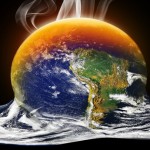This interesting article appeared on Rawstory:
By Philip Kokic, CSIRO; Mark Howden, CSIRO, and Steven Crimp, CSIRO
There is less than 1 chance in 100,000 that global average temperature over the past 60 years would have been as high without human-caused greenhouse gas emissions, our new research shows.
Published in the journal Climate Risk Management today, our research is the first to quantify the probability of historical changes in global temperatures and examines the links to greenhouse gas emissions using rigorous statistical techniques.
Our new CSIRO work provides an objective assessment linking global temperature increases to human activity, which points to a close to certain probability exceeding 99.999%.
Our work extends existing approaches undertaken internationally to detect climate change and attribute it to human or natural causes. The 2013 Intergovernmental Panel on Climate Change Fifth Assessment Report provided an expert consensus that:
It is extremely likely [defined as 95-100% certainty] that more than half of the observed increase in global average surface temperature from 1951 to 2010 was caused by the anthropogenic [human-caused] increase in greenhouse gas concentrations and other anthropogenic forcings together.
Decades of extraordinary temperatures
July 2014 was the 353rd consecutive month in which global land and ocean average surface temperature exceeded the 20th-century monthly average. The last time the global average surface temperature fell below that 20th-century monthly average was in February 1985, as reported by the US-based National Climate Data Center.
This means that anyone born after February 1985 has not lived a single month where the global temperature was below the long-term average for that month.
We developed a statistical model that related global temperature to various well-known drivers of temperature variation, including El Niño, solar radiation, volcanic aerosols andgreenhouse gas concentrations. We tested it to make sure it worked on the historical record and then re-ran it with and without the human influence of greenhouse gas emissions.
Our analysis showed that the probability of getting the same run of warmer-than-average months without the human influence was less than 1 chance in 100,000.
We do not use physical models of Earth’s climate, but observational data and rigorous statistical analysis, which has the advantage that it provides independent validation of the results.
Detecting and measuring human influence
Our research team also explored the chance of relatively short periods of declining global temperature. We found that rather than being an indicator that global warming is not occurring, the observed number of cooling periods in the past 60 years strongly reinforces the case for human influence.
We identified periods of declining temperature by using a moving 10-year window (1950 to 1959, 1951 to 1960, 1952 to 1961, etc.) through the entire 60-year record. We identified 11 such short time periods where global temperatures declined.
Our analysis showed that in the absence of human-caused greenhouse gas emissions, there would have been more than twice as many periods of short-term cooling than are found in the observed data.
There was less than 1 chance in 100,000 of observing 11 or fewer such events without the effects of human greenhouse gas emissions.
The problem and the solution
Why is this research important? For a start, it might help put to rest some common misunderstandings about there being no link between human activity and the observed, long-term trend of increasing global temperatures.
Our analysis – as well as the work of many others – shows beyond reasonable doubt that humans are contributing to significant changes in our climate.
Good risk management is all about identifying the most likely causes of a problem, and then acting to reduce those risks. Some of the projected impacts of climate change can be avoided, reduced or delayed by effective reduction in global net greenhouse gas emissions and by effective adaptation to the changing climate.
Ignoring the problem is no longer an option. If we are thinking about action to respond to climate change or doing nothing, with a probability exceeding 99.999% that the warming we are seeing ishuman-induced, we certainly shouldn’t be taking the chance of doing nothing.
![]()
The authors do not work for, consult to, own shares in or receive funding from any company or organisation that would benefit from this article. They also have no relevant affiliations.
This article was originally published on The Conversation.
Read the original article.
